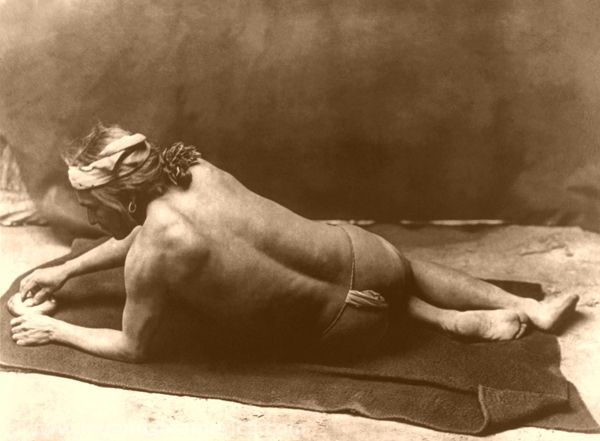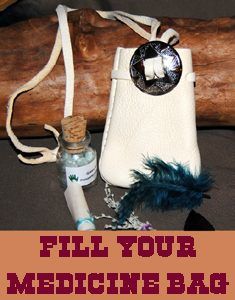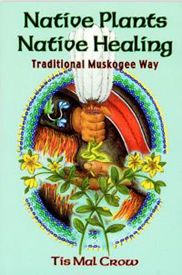For thousands of years, Native Americans have used herbs to heal the body, purify the spirit, and bring balance into their lives and surroundings. Oral traditions indicate that they learned about the healing powers of herbs and other plants by watching sick animals. There are no written records of herbal use by the indigenous people of America before the first contact between Europeans and the tribes. However, this changed as Native Americans shared their knowledge of how to use nature’s medicines with the new settlers.
While hundreds of herbs and plants were used in Native American remedies, one of the most sacred was tobacco, which was used to heal numerous conditions, rituals, and ceremonies. It was smoked pure and not mixed with any chemicals as it is today.
Another essential herb to the Native Americans was Sage, which was said to not only heal multiple problems of the stomach, colon, kidneys, liver, lungs, skin, and more, but it was also believed to protect against harmful spirits and to draw them out of the body or the soul.
Though the list of medicinal herbs that might be carried in a Healer’s medicine bundle are many and varied, those that were most often used were frequently carried, such as remedies for common colds, which might include American Ginseng or Boneset; herbs for aches and pains including Wild Black Cherry, Pennyroyal, and Hops; remedies for fever, including Dogwood, Feverwort, and Willow Bark.
This list includes many herbs used by Native Americans and others that have been beneficial for various ailments throughout history. It also contains herbs used for many of today’s ailments. Please note that some herbs used in history are no longer recommended today. By clicking on the links, more information can be found on each herb, its history, and its uses.
Ailment or Drug Type:
Remedies Home A B C D E F G H I J K L M N O P Q R S T U V W X Y Z
A
Abdominal Pain/Cramps:
- Cattail – Utilized as food and in external and internal medical remedies.
- Galangal – Similar to other ginger-related herbs, it is primarily used for digestive disorders.
- Sage – Used for thousands of years in cooking, and like other culinary herbs, it has long been thought to be a digestive aid and appetite stimulant.
- Saw Palmetto – Long prized as a food product, it was also used by Native Americans to make baskets and fans, as well as in medicinal remedies.
Abortifacient:
- Pennyroyal – Long used to treat medical problems and to eradicate pests. Pennyroyal should not be used in any way by pregnant women. Over-ingestion of this herb has caused death.
- Rosemary – Used for culinary purposes and in medicinal remedies.
- Skullcap – A powerful medicinal herb, it was cultivated by Native Americans for use in several remedies. Pregnant women should not take Skullcap.
- Slippery Elm – The tree had many traditional uses by Native Americans.
Abscesses:
- Burdock – Roots, and leaves utilized internally and externally. Avoid if pregnant or nursing.
- Devil’s Claw – Used in teas and tonics internally and in poultices externally. It should not be used by women who are or may be pregnant.
- Echinacea – Roots were chewed, dried in tea, or pulverized for external use.
- Chamomile – Commonly used in teas, it is best known to help with sleep.
- Pau d’arco – Long used for various conditions.
- Poke – Though parts of this plant are highly toxic to livestock and humans, it has long been used as food and medicine by Native Americans.
- White Pine – The inner bark, young shoots, twigs, pitch, and leaves have long been used by Native Americans in medical remedies.
- Slippery Elm – The tree had many traditional uses by Native Americans.
- Wild Yam – Traditionally used as food and medicine.
Aches:
- Black Cohosh – Roots of the plant were used in teas for various ailments.
- Osha – Having a wide variety of medicinal properties, Osha was highly valued by Native Americans.
- Saltbush – Many species are used for various conditions.
Acne:
- Buffaloberry – Used as food and in herbal remedies. Overindulgence can cause severe problems, including death.
- Burdock – Roots, and leaves utilized internally and externally. Avoid if pregnant or nursing.
- Cat’s Claw – Used in teas and tonics for over 2,000 years.
- Chasteberry – Berries and flowers used in teas. Pregnant or breastfeeding women should not take Chasteberry.
- Dandelion – Used in both foods and internal and external medical remedies.
- Lavender – Dating back to Roman times, Lavender has been used in teas, balms, food, and medicinal remedies.
- Mint – Dried leaves used in teas and food, found helpful in several remedies.
- Red Clover – Traditionally used for several conditions.
- Sarsaparilla – Used for centuries in a wide variety of medicinal remedies.
- Witch Hazel – Widely used for medicinal purposes by American Indians.
- Yellow Dock – Native Americans as traditional medicine and food.
ADHD:
- Ginko Biloba – One of the most ancient trees, it has been used for food and medicine.
- Lavender – Dating back to Roman times, Lavender has been used in teas, balms, food, and medicinal remedies.
- Oat Straw – food source and medical remedy since prehistoric times.
- Skullcap – A powerful medicinal herb, it was cultivated by Native Americans for use in several remedies. Pregnant women should not take Skullcap.
- St John’s Wort – Most commonly known as an anti-depressant, it also has other medical uses.
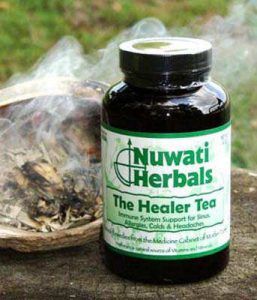
Nuwati Healer Tea for Sinuses, Colds, Headaches, Allergies, and Immune System. At Legends’ General Store
Allergies:
- Dong Quai – Used for over a thousand years to treat several conditions.
- Mint – Dried leaves used in teas and food, found helpful in several remedies.
- Rooibos – Used in teas to help with various conditions.
- Goldenrod – Long used for various ailments.
- Spirulina – A type of blue-green algae rich in protein and vitamins.
Alzheimer’s Disease:
- Ginko Biloba – One of the most ancient trees, it has been used for food and medicine.
Anemia:
- Dong Quai – Used for over a thousand years to treat several conditions.
- Senna – A large genus of flowering plants found to be helpful in many remedies.
- Wheat Grass – The result of centuries of cultivation, it is used for numerous medical conditions.
Antibiotic:
- Ashwagandha – The whole plant is used in numerous remedies. Caution is advised in the use of this plant since it is toxic.
Antiseptic:
- Fenugreek – Used internally and externally for various medicinal purposes.
- Grapefruit – Seeds, pulp, and inner rind are used for internal conditions.
- Horsemint – Leaves and flowering stems used in teas, tonics, and salves for various medical issues. Pregnant women should not use it.
- Lavender – Dating back to Roman times, Lavender has been used in teas, balms, food, and medicinal remedies.
- Pinon – Used so extensively by Native Americans that some tribes referred to it as the “tree of life.”
- Prickly Pear Cactus – Native Americans used the younger pads for food and teas, while mature pads were used in poultices.
- Stiff Goldenrod – Long been used to stop bleeding and other ailments.
- Sumac – Viewed by some tribes as a sacred plant, Sumac was used for food and medicine.
- White Willow – The use of willow bark dates back thousands of years.
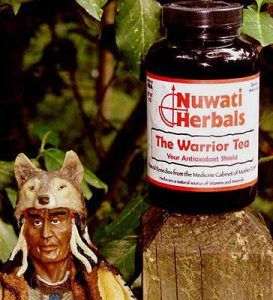
The Warrior Tea – Antioxidant tea for general good health, helps the heart and heal wounds, promotes digestion, and improves mental processes. Available at Legends’ General Store
Antioxidant:
- Ginko Biloba – One of the most ancient trees, it has been used for food and medicine.
- Grapefruit – Seeds, pulp, and inner rind are used for internal conditions.
- Olive Oil – A traditional tree crop long used in foods and medicines.
- Sarsaparilla – Used for centuries in a wide variety of medicinal remedies.
- Schisandra – A genus of shrub that has many medicinal uses.
- Spirulina – A type of blue-green algae rich in protein and vitamins.
- White Willow – The use of willow bark dates back thousands of years.
Anxiety:
- Damiana – Used internally for various medical issues.
- Hops – Though most commonly known for its use in beer, it also has medicinal properties.
- Kava Kava – Used there for thousands of years as a folk remedy and a social and ceremonial beverage.
- Kola Nut – Long used in medicinal remedies, spiritual practices, and ceremonies. It should not be used by pregnant or nursing women or those with intestinal or stomach ulcers, blood pressure, insomnia, or heart disorders.
- Lavender – Dating back to Roman times, Lavender has been used in teas, balms, food, and medicinal remedies.
- Lemon Balm – A calming herb used since the Middle Ages.
- Passion Flower – Has a long history of use among Native Americans and was adopted by early European colonists. Do not take passionflower if you are pregnant or breastfeeding.
- Peppermint – Besides flavoring, it has long been used in traditional medicine for its calming and numbing effects. It should not be used or given to infants or small children.
- Rhodiola – Best known for improving physical and mental performance.
- Skullcap – A powerful medicinal herb, it was cultivated by Native Americans for use in several remedies. Pregnant women should not take Skullcap.
- St John’s Wort – Most commonly known as an anti-depressant, it also has other medical uses.
- Valerian Root – Has been used as a medicinal herb since at least the time of ancient Greece and Rome.
- Wild Lettuce – Indigenous to North America, it was used for sedative purposes, especially in nervous complaints.
Aphrodisiac:
- Damiana – Used internally for various medical issues.
- Guarana – Containing caffeine, it has many of the same effects as coffee.
- Savory – An aromatic herb used as a spice and in folk medicine.
Appendicitis:
- Dandelion – Used in both foods and internal and external medical remedies.
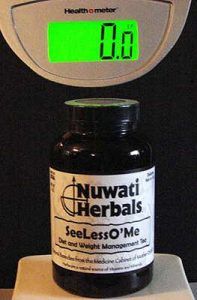
SeeLessO’Me Tea – For diet, appetite suppressant, energy, laxative, stomach soother, and more. Available at Legends’ General Store
Appetite Stimulant:
- Devil’s Claw – Used in teas and tonics internally and in poultices externally. It should not be used by women who are or may be pregnant.
- Dogwood – Bark, berries, and twigs used in decoctions internally and externally.
- Fennel – Seeds, leaves, and roots used in cooking and medicinal remedies.
- Fenugreek – Used internally and externally for various medicinal purposes.
- Gentiana – Extremely bitter herb used for both internal and external problems. It may irritate persons with ulcers and may also cause headaches, nausea, or vomiting.
- Ginger Root – Utilized as both a spice and medicine throughout the world.
- Horehound – Whole plant used internally and externally. People with gastritis or peptic ulcer disorders should use it cautiously.
- Lemon Balm – A calming herb used since the Middle Ages.
- Rabbit Tobacco – Was thought to have had spiritual or mystic powers by many Indians.
- Sage – Used for thousands of years in cooking, and like other culinary herbs, it has long been thought to be a digestive aid and appetite stimulant.
- Saw Palmetto – Long prized as a food product, it was also used by Native Americans to make baskets and fans, as well as in medicinal remedies.
- Star Anise – The fruit of a small tree with a licorice-like flavor long used in medical remedies.
- Wild Black Cherry – The dried inner bark was traditionally used in tea or syrups for several health problems.
- Wild Garlic – Used throughout its history for both culinary and medicinal purposes.
- Wild Ginger – Native Americans used the roots as a seasoning and medicinal herb.
- Wormwood – The leaves and flowering tops were gathered and dried to use in medicinal tonics.
Appetite Suppressant:
- Bee Pollen – One of the oldest health foods used by man, it is mixed with food or drinks or as a pill supplement today.
- Dandelion – Used in both foods and internal and external medical remedies.
- Garcinia Cambogia – Fruit rind used in various remedies. Not recommended for those with diabetes, people suffering any dementia syndrome or pregnant and lactating women.
- Guarana – Containing caffeine, it has many of the same effects as coffee.
- Kola Nut – Long used in medicinal remedies, spiritual practices, and ceremonies. It should not be used by pregnant or nursing women or those with intestinal or stomach ulcers, blood pressure, insomnia, or heart disorders.
- Yerba Mate – A Holly species with a long history as a medicinal herb.
Arthritis:
- Alfalfa – Utilized in teas or added to food for various medicinal remedies. Avoid if you have an auto-immune problem.
- Black Cohosh – Roots of the plant were used in teas for various ailments.
- Boneset – Dried leaves are used in tea. Caution is advised as it is toxic and has side effects.
- Boswellia – Fragrant resin utilized in various ailments. Pregnant, breastfeeding women and children should not use it.
- Buffaloberry – Used as food and in herbal remedies. Overindulgence can cause severe problems, including death.
- Devil’s Claw – Used in teas and tonics internally and in poultices externally. It should not be used by women who are or may be pregnant.
- Eucalyptus – Teas and ointments used for various purposes.
- Feverfew – Used for various internal medical problems. It should not be used by women who are pregnant.
- Ginger Root – Utilized as both a spice and medicine throughout the world.
- Goldenrod – Long used for various ailments.
- Green Tea – Made solely with the leaves of Camellia Sinensis, it is known for its many helpful properties.
- Greenbriar – Teas and salves used internally and externally.
- Guarana – Containing caffeine, it has many of the same effects as coffee.
- Juniper – Used internally and externally for medicinal purposes. Pregnant women should not use this herb as it has been known to cause miscarriage.
- Osha – Having a wide variety of medicinal properties, Osha was highly valued by Native Americans.
- Pau d’arco – Long used for a broad range of conditions.
- Poke – Though parts of this plant are highly toxic to livestock and humans, it has long been used as food and medicine by Native Americans.
- Sarsaparilla – Used for centuries in a wide variety of medicinal remedies.
- Shavegrass – Used for centuries as a remedy for various medical conditions.
- Slippery Elm – The tree had many traditional uses by Native Americans.
- Stoneseed – Seeds used for several medical ailments.
- White Pine – The inner bark, young shoots, twigs, pitch, and leaves have long been used by Native Americans in medical remedies.
- Wild Garlic – Used throughout its history for both culinary and medicinal purposes.
- Yellow Dock – Native Americans as traditional medicine and food.
Asthma:
- Boswellia – Fragrant resin utilized in various ailments. It should not be used by pregnant, breastfeeding women and children.
- Coltsfoot – This dandelion-looking plant has been used medicinally throughout the world for thousands of years for numerous purposes.
- Damiana – Used internally for various medical issues.
- Eastern Skunk Cabbage – Dried leaves are used as a seasoning in remedies and as a magical talisman by various tribes.
- Evening Primrose – Used for food and medicinal remedies, decoctions were used for internal and external ailments.
- Feverfew – Used for various internal medical problems. It should not be used by women who are pregnant.
- Goldenrod – Long used for various ailments.
- Honeysuckle – Used in traditional herbal remedies for thousands of years.
- Horehound – Whole plant used internally and externally. People with gastritis or peptic ulcer disorders should use it cautiously.
- Indian Hemp – A type of marijuana used to make clothes, rope, and paper, as well as boiling the roots into teas for medicinal problems.
- Kola Nut – Long used in medicinal remedies, spiritual practices, and ceremonies. It should not be used by pregnant or nursing women or those with intestinal or stomach ulcers, blood pressure, insomnia, or heart disorders.
- Lemongrass – Having anti-fungal properties, it has not only been used as an herbal medicine but also as a pesticide and preservative.
- Mullein – A tobacco-like plant and one of the oldest herbs, it has a long history of use as a medicine
- Poke – Though parts of this plant are highly toxic to livestock and humans, it has long been used as food and medicine by Native Americans.
- Rabbit Tobacco – Was thought to have had spiritual or mystic powers by many Indians.
- Rooibos – Used in teas to help with various conditions.
- Sumac – Viewed by some tribes as a sacred plant, Sumac was used for food and medicine.
- Wild Black Cherry – The dried inner bark was traditionally used in tea or syrups for several health problems.
- Wild Garlic – Used throughout its history for both culinary and medicinal purposes.
- Wild Ginger – Native Americans used the roots as a seasoning and medicinal herb.
- Wild Onion – Traditionally used as food and medicine.
- Yarrow – Used for thousands of years, especially to stop bleeding.
Astringent:
- Grapefruit – Seeds, pulp, and inner rind are used for internal conditions.
- Raspberry – Leaves and fruits are used in various medical issues.
- Rose Hip – The fruit of the rose plant has long been used in teas to soothe various problems.
- Stiff Goldenrod – Long been used to stop bleeding and other ailments.
- Sumac – Viewed by some tribes as a sacred plant, Sumac was used for food and medicine.
- Yarrow – Used for thousands of years, especially to stop bleeding.
Disclaimer: These statements have not been evaluated by the Food and Drug Administration, and we make no medical claims nor intend to diagnose, treat, or heal medical conditions. Pregnant or nursing women or persons with known medical conditions should consult their physician before taking any herbal products.
Remedies Home A B C D E F G H I J K L M N O P Q R S T U V W X Y Z

